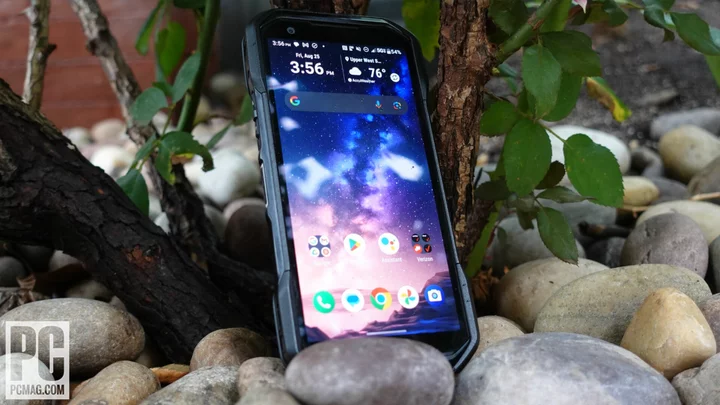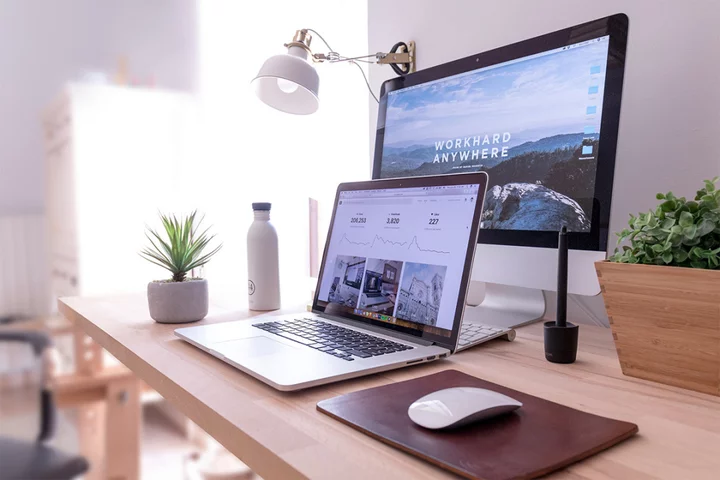The Verizon-exclusive Kyocera DuraForce Pro 3 ($899.99) is built to survive extreme environments such as construction sites, warehouses, and backcountry that might otherwise imperil regular smartphones. It includes 5G connectivity with C-band support, has push-to-talk functionality, and features configurable buttons in a toughened dustproof and waterproof design that’s ready to rock. Though we aren't impressed by its camera, there isn’t much competition for rugged phones in the US, and the DuraForce Pro 3 is a better buy than both the Kyocera DuraForce Ultra 5G ($899.99) and the Sonim XP10 ($569.99).
Built to Last
At first glance, the DuraForce Pro 3 looks like an older phone with big bezels surrounding a relatively small screen that's protected by a sturdy plastic case. It measures 6.06 by 2.95 by 0.57 inches (HWD) and has a unique shape because of some rounded bumper areas, some angled areas, more buttons than usual, and slots to attach the phone to a lanyard. Generally speaking, the DuraForce Pro 3 feels light in the hand even if it is a bit on the bulky side. It weighs in at 8.36 ounces, which is a lot lighter than the 11.3-ounce Sonim XP10. The XP10 is also larger at 6.3 by 3.0 by 0.6 inches, making the Pro 3 easier to grip when wearing gloves.
(Credit: Iyaz Akhtar)The DuraForce Pro 3 has a 5.38-inch OLED display with a resolution of 2,160 by 1,080 pixels and a 60Hz refresh rate. It's covered in Gorilla Glass Victus with DX+, making it more scratch-resistant than regular Gorilla Glass Victus and less reflective when used outdoors. The screen has a maximum brightness of 650 nits, which is typically good, but in this case it was sometimes difficult to see under direct sunlight.
A selfie camera fills some of the space in the thick bezel above the display with the earpiece speaker taking up the rest in a recessed cavity. In testing, we found the cavity around the speaker catches some debris in pockets.
The DuraForce Pro 3 has a number of configurable buttons. The programmable keys can serve multiple functions, as you can assign single-press, double-press, and press-and-hold actions to each. This gives you a number of ways to interact with the phone without touching the screen. Additionally, the programmable buttons are unique in size and are textured so you can differentiate them by feel.
(Credit: Iyaz Akhtar)A round, orange SOS key is positioned on the top edge of the device. On the left side, you’ll find two volume keys and a dedicated push-to-talk button. The right side has a combination fingerprint sensor/power button and a camera button. The fingerprint sensor was responsive in testing and rarely required a second press. The bottom of the device features a USB-C port (USB 3.2 Gen 1), which you can access by peeling back a protective flap. Two speaker grilles are stuffed between the display and the bottom of the phone.
(Credit: Iyaz Akhtar)The main camera assembly sits just slightly below the back casing. The rear surface is mostly a textured plastic panel which is removable by twisting a metal screw. The removable 4,270mAh battery under the panel is secured by an orange slide-lock mechanism that must be disengaged to take the battery out and re-engaged when the battery is replaced, otherwise the rear panel won’t sit properly. Helpful graphics show how it works.
Like an old-school phone, the SIM and microSD card slots are hidden beneath the battery. The phone supports dual SIM cards as well as memory cards up to 1TB in capacity.
(Credit: Iyaz Akhtar)Even with the removable back, battery, and SIM tray, the Pro 3 is rated at IP68, meaning it is fully dustproof and can withstand being submerged in 1.5 meters of water for up to 30 minutes. Kyocera also says the phone meets MIL-STD-810H standards, which means it can handle drops, shock, extreme temperatures and elevations, and fog and salt. The company says the Pro 3 is HazLoc certified Non-Incendive, Class I, Div 2, which means that it does not produce arcs, sparks, or hot surfaces and is thus safe to use in hazardous environments, such as those with flammable gasses.
We didn't test the phone at extreme temperatures, but we did evaluate its general durability. We repeatedly tossed the phone onto rocks, leaves, and dirt. Each time we picked it up, we noticed no damage to the screen or body, and it operated without a hitch even after being submerged in water.
Enough Power for Basic Tasks
Inside you will find a Qualcomm Snapdragon 7 Gen 1 powering the DuraForce Pro 3, which is an unusual choice for a phone in the US market. For reference, the Snapdragon 7 Gen 1 was introduced in 2022 and is mostly used in phones sold in Asia. The Pro 3 ships with 6GB of RAM and 128GB of onboard storage.
(Credit: Iyaz Akhtar)In testing, the DuraForce Pro 3 handled non-intensive tasks without issue. Productivity apps like Gmail, Google Drive, and Google Docs loaded quickly and worked quite well. However, running lots of apps at one time caused the phone's performance to dip in a noticeable way. The camera app, in particular, struggled no matter how many apps were open (or not).
The Pro 3 scored 777 in the GeekBench 6 single-core test and 2,229 in the multicore test. Meanwhile, the Sonim XP10 scored 545 and 1,557 on the single-core and multi-core tests, respectively, in GeekBench 5.5. This isn't quite an apples-to-apples comparison, but you get the general idea.
On the PCMark Work 3.0 test, which evaluates general mobile tasks, the Pro 3 scored 9,526 which is much better than the XP10's 7,356. The Pro 3's performance on this benchmark puts it in the same neighborhood as the Google Pixel 6a, which scored 9,558.
(Credit: Geekbench/PCMark)We doubt that Pro 3 buyers will spend much of their time gaming, and it’s no surprise that gaming performance was not great. For example, when playing Genshin Impact at medium settings (60fps), we noticed frequent frame drops to the point that the video was reminiscent of a flip book. When on low settings (30fps), performance was better, but we still experienced occasional dropped frames. Less intensive games like Alto's Odyssey and Mario Kart Tour ran without any hiccups, however. Regardless of the game, the phone remained relatively cool to the touch and never became uncomfortably warm.
In our battery tests, during which we stream HD video over Wi-Fi with the display at full brightness, the Pro 3 lasted approximately 13 hours, which is two hours better than the Sonim XP10. It took about 1 hour and 37 minutes to get the Pro 3's battery from 0 to 100%. A 15-minute charge brought the phone up to 21% in testing. You have to supply your own charging brick and wireless charging isn't supported. The phone has an LED on the top bezel that glows red while charging and turns green when the battery reaches 100%, which is handy.
Solid Radio Performance
The Pro 3 supports the most modern set of spectrum bands for Verizon’s 5G network. That means C-band and mmWave, though our test results demonstrated limited performance.
On Verizon's network in New York City, the Pro 3 reached speeds of 674Mbps down and 111Mbps up. The Samsung Galaxy S23 Ultra tested in the same spot pulled in a mind-boggling 3Gbps (or 3,000Mbps) down, while its upload speed reached 99.4Mbps.
The Pro 3 supports Wi-Fi 6E, but not Wi-Fi 7. When connected to a Wi-Fi 6 access point in testing, peak download speeds hit 471Mbps while uploads topped out at 12.8Mbps (that slow upload speed is more a function of the ISP than the phone). For comparison, the S23 Ultra also hit 471Mbps down, but uploads topped out higher at 20.7Mbps when tested in the same spot.
Taking the DuraForce Pro 3 as far away as possible from the access point in my apartment, speeds dropped to 59.9Mbps down and 12.8Mbps up, while the Galaxy S23 Ultra reached 192Mbps down and 19.2Mbps up. In other words, Wi-Fi performance is very good for the Pro 3 when close to an access point but suffers somewhat as you move away.
(Credit: Iyaz Akhtar)Kyocera says the front-facing stereo speakers can reach over 100dB. In our tests, in which we place a Vlike sound meter on a flat surface six inches away from the phone's main speaker, we saw a maximum volume of 94.5dB. When listening to music, highs were crisp with no distortion even with the volume maxed out, though bass quality was nothing to write home about. If you want to enjoy the full dynamic range of your music, we suggest using a good pair of Bluetooth headphones. The Pro 3 supports Bluetooth 5.2 for connecting to accessories, as well as NFC for tap-and-go mobile payments.
Kyocera claims the Pro 3 uses AI-enhanced noise cancellation for calls. We tested this feature by leaving a voicemail while standing near some road construction with a jackhammer running in the background. There was no hint of the jackhammer noise on the voicemail, which is impressive, but the speech sounded unnatural, with an underwater-like sound. When the jackhammer stopped, the voicemail became normal and clear. Talking at a louder volume when the jackhammer was running led to a clearer sound, though it was still a bit muddy. The earpiece speaker reached 74.8dB and was easy to hear even with the jackhammer or loud music playing in the background. If the earpiece wasn't loud enough in a given environment, switching to the speakerphone made calls more audible.
Mediocre Cameras
Cameras on ruggedized phones generally pale in comparison with traditional smartphones, as photography is not often the main selling point of a tough device. The main shooter here is a 64MP camera that takes 16MP images (via quad-binning). It is joined by a 16MP wide-angle camera with a 117-degree field of view, and a 2MP macro camera. In testing, the default camera app proved frustrating. It was often slow to switch modes and crashed during video tests.
I reached out to Kyocera and it confirmed that the camera app can be sluggish when used in low-light settings. The company said it is addressing the issue but stopped short of promising a patch or update. Kyocera also said the Auto HDR feature can affect timing and that it can be turned off to assist performance. Further, the company suggested reducing the number of camera modes that appear in the camera app by going into the camera settings and unchecking modes that are not needed regularly.
To give the Pro 3 a fair shot, I reset the device to factory settings to retest and tried Kyocera's tweaks and found the default camera app did work better than before, though it was still sluggish compared with most other phones.
(Credit: Iyaz Akhtar)Realistically, the cameras on the Pro 3 are most likely going to be used to grab images of a worksite or machinery. Color accuracy and portraits probably won't be top of mind for many end users in these scenarios. If you want to get the best pictures out of the Pro 3, you will need bright lighting and a bit of patience. Dark details are often lost, and switching modes in the camera app takes a bit of time.
Ultrawide camera (Credit: Iyaz Akhtar)The regular camera preserved more detail compared with the ultrawide. Colors looked good but appeared darker than what my eyes saw, with fine details often muddy or lost altogether. Turning off the HDR function led to faster performance, but that resulted in a further loss of detail.
Main camera (Credit: Iyaz Akhtar)Low-light photography was pretty bad. In my standard test, wherein I take pictures of a guitar next to a colorful bag in a dark room, the tuning pegs and the bag are barely visible.
Left: Lights on. Middle: Lights off, night mode on. Right: Middle image edited in Google Photos (Credit: Iyaz Akhtar)Video captured from the rear camera tops out at 4K at 24fps. Colors appeared dark, with details lost entirely in darker scenes.
The Pro 3 also has an underwater photography mode, which disables the touch screen except for the thumbnail area. Photos are taken using the camera button; the volume buttons act as zoom controls. I tested this by placing the Pro 3 in a glass bowl and taking pictures through the bowl. Colors looked good but were a bit muted.
Underwater photography sample (Credit: Iyaz Akhtar)Straightforward Software
The DuraForce Pro 3 runs on Android 13 and will get two OS updates with security patches until July 2026. This level of support could be better. Other devices like the Google Pixel 7 Pro will get OS updates for three years and security patches for five. By way of comparison, the Sonim XP10 ships with Android 12 and will receive only one system update (to Android 13) with security updates through 2025. If software support is important, the Kyocera is a better choice.
The version of Android on this device is not stock, as you can immediately tell by the customized quick-setting tiles, a unique screen unlock mechanism, and the app drawer. The lock screen, for example, has quick options that let you swipe up to type in your PIN or passcode, swipe left for the camera, or right for Google Assistant. You cannot map these areas to other apps.
(Credit: Iyaz Akhtar)Like other devices, you can search the app drawer for whatever app you seek. Unlike other launchers, search results cannot be long-pressed to bring the icon to the home screen, but can be tapped to launch. We found the scroll animations in the app drawer to be a bit jerky.
(Credit: Iyaz Akhtar)Kyocera put the classic Android three-button navigation control on the bottom by default, which makes sense if you need big targets or if using gestures is inconvenient. The downside of the three-button navigation is that it takes up some screen real estate. However, you can always switch to the gesture-based system if you prefer.
(Credit: Iyaz Akhtar)The Pro 3 comes with some Verizon bloatware preinstalled, which you can find in a folder on the default home screen. Verizon apps include Call Filter, Verizon Cloud, Digital Secure, PTT, and voicemail.
The DuraForce Pro 3 can be also used while wearing gloves if Glove Touch Mode is activated in Settings, which increases the sensitivity of the screen. Swipes and taps were recognized consistently, although typing was difficult, but that's par for the course when wearing gloves.
Tough Enough for Work
If you're looking for a rough-and-tumble phone on Verizon that can handle unfriendly environments, the Kyocera DuraForce Pro 3 is hard to beat. Its replaceable battery, expandable storage, decent radio performance, and overall degree of toughness make the phone a dependable choice for its intended market of construction, warehouse, and farm workers. If you're not on Verizon's network, take a look at the Sonim XP10, which offers a lot of the same features and can be found at AT&T and T-Mobile for a couple of hundred dollars less. Mainstream phone buyers, meanwhile, should look to models like the Apple iPhone Pro, the Google Pixel 7, and the Samsung Galaxy S23+, all of which are similarly priced, waterproof, and offer better cameras, displays, and overall performance.









